Module 11 Unit 1 They touch noses!课件 1(37张)
文档属性
| 名称 | Module 11 Unit 1 They touch noses!课件 1(37张) |  | |
| 格式 | ppt | ||
| 文件大小 | 2.1MB | ||
| 资源类型 | 教案 | ||
| 版本资源 | 外研版 | ||
| 科目 | 英语 | ||
| 更新时间 | 2022-05-19 12:51:02 | ||
图片预览

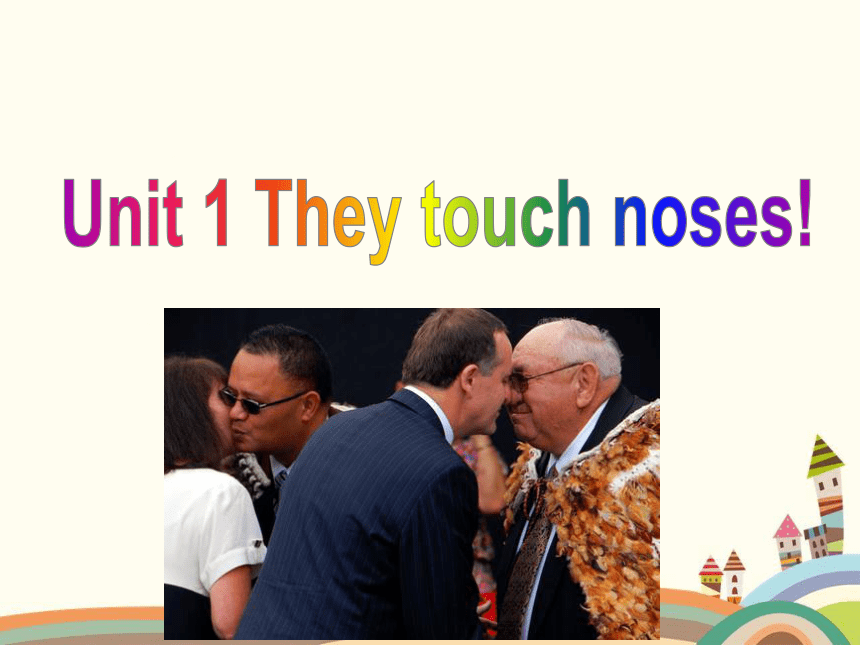
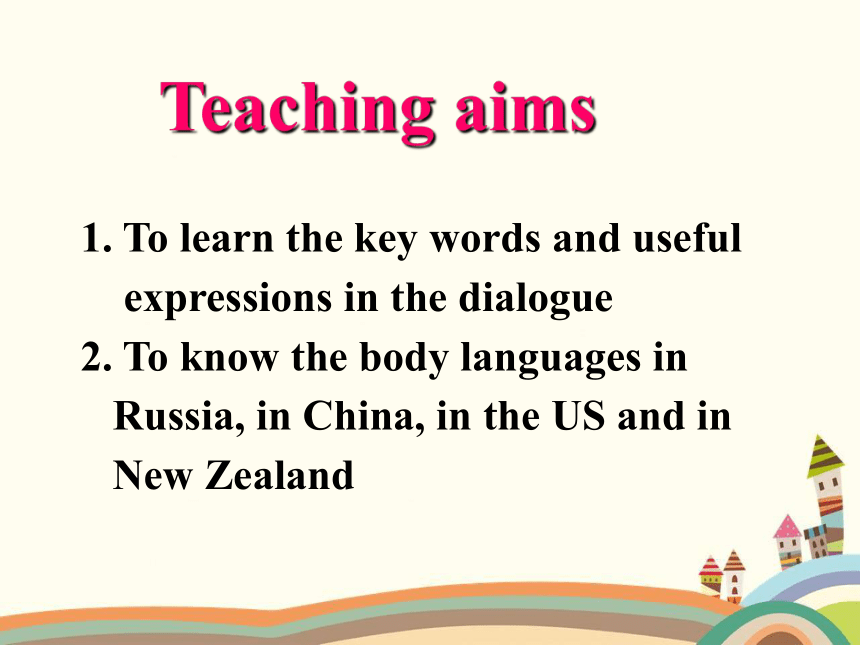
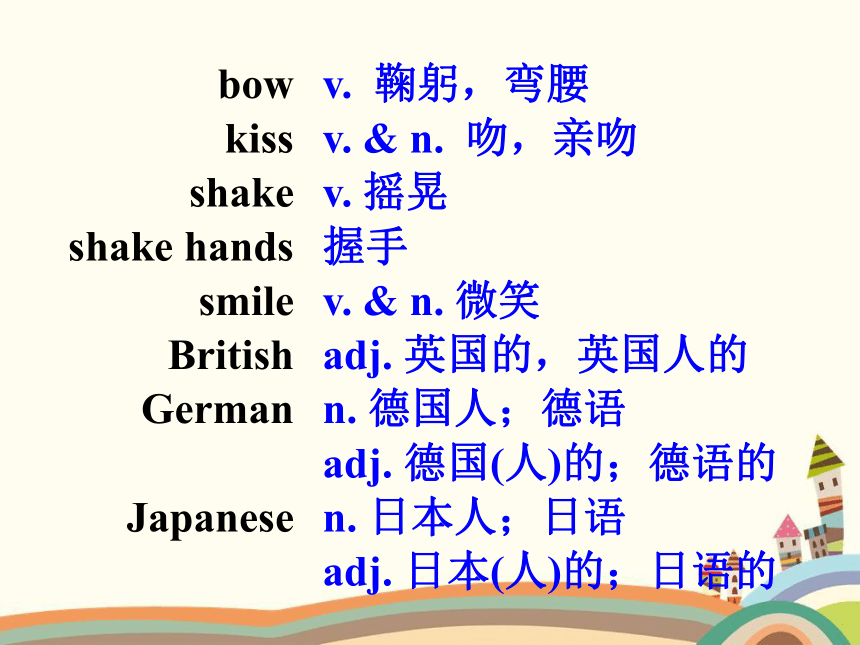
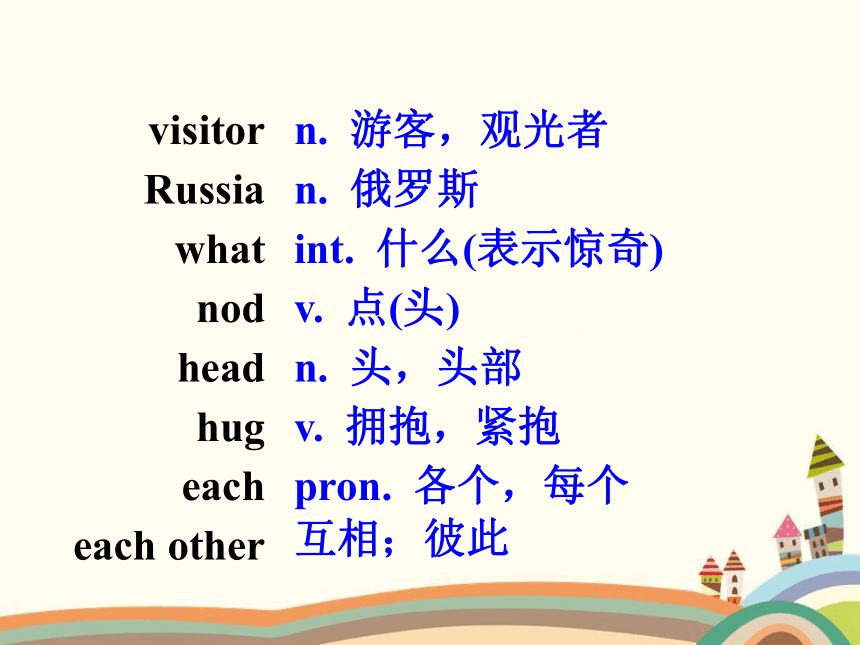
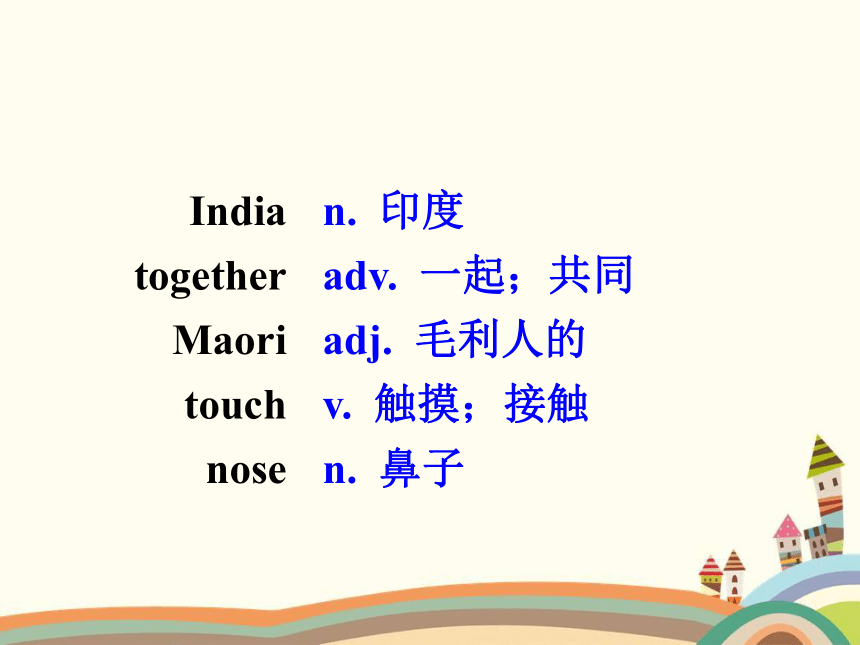
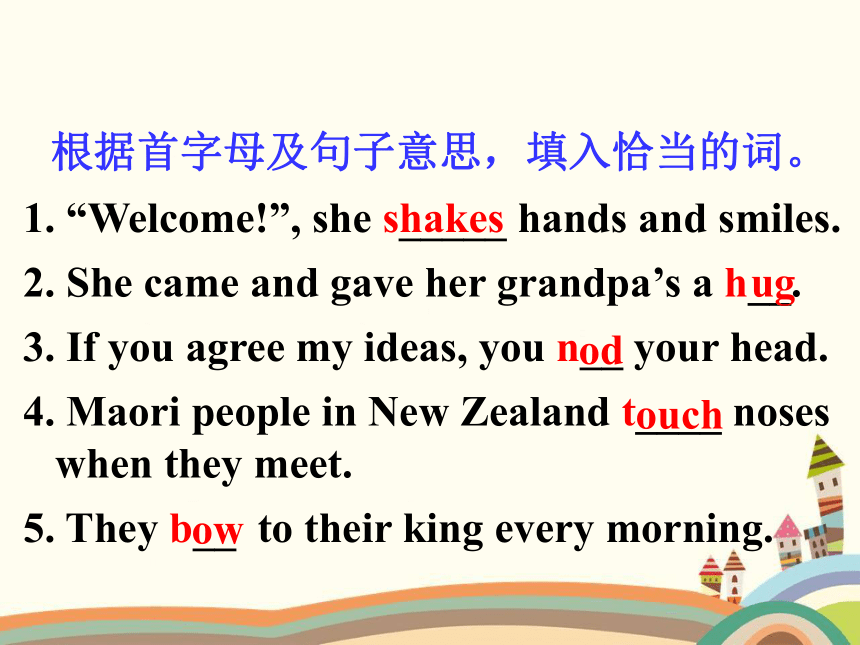
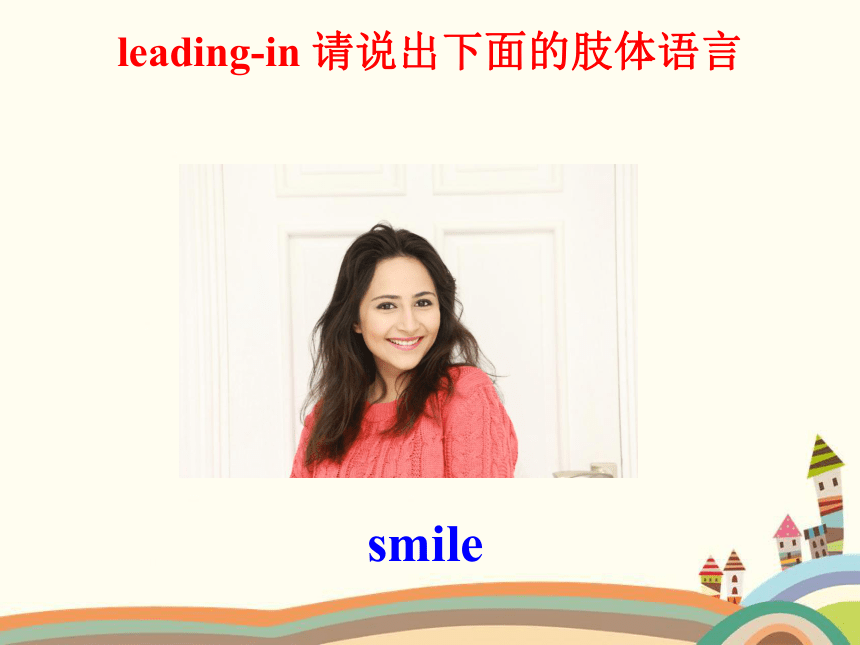
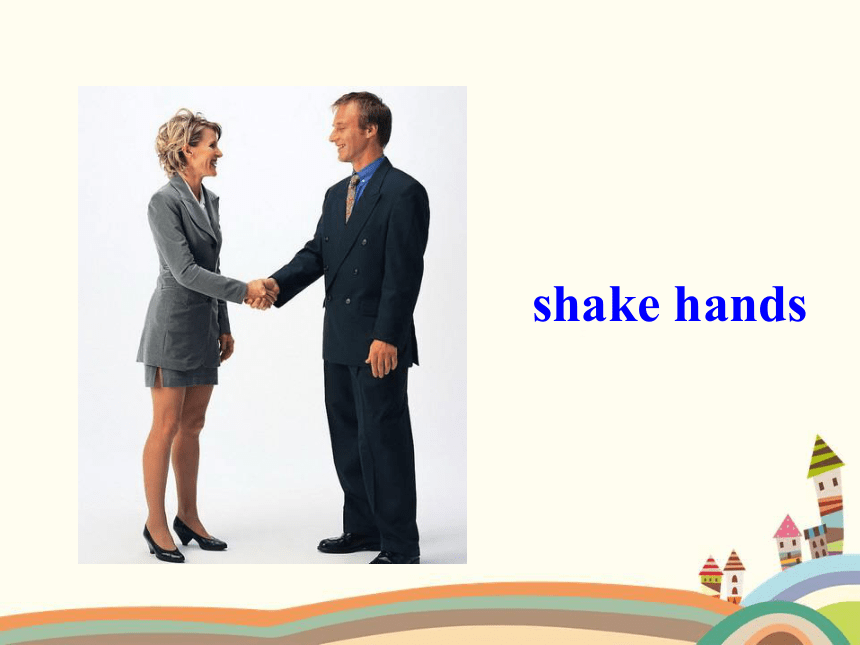
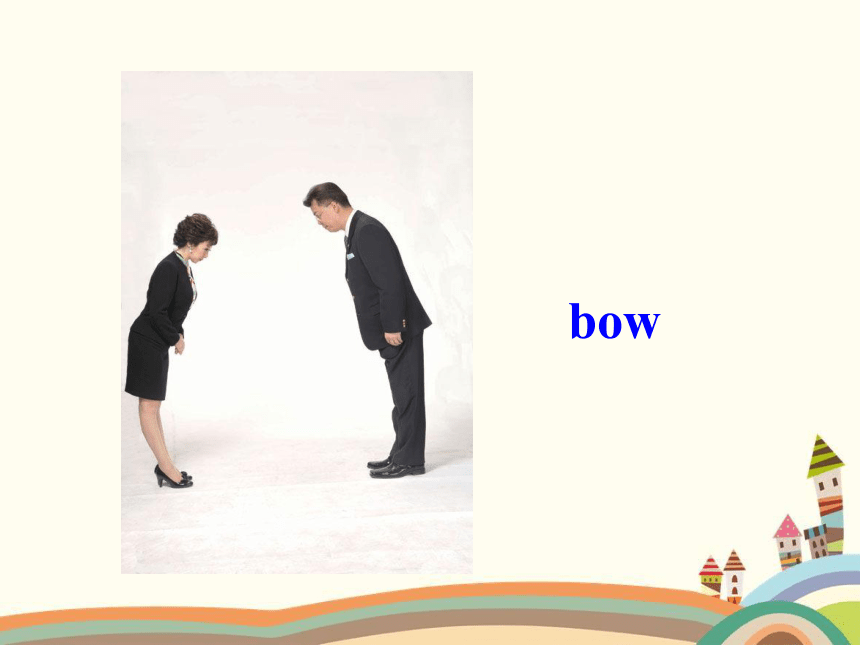
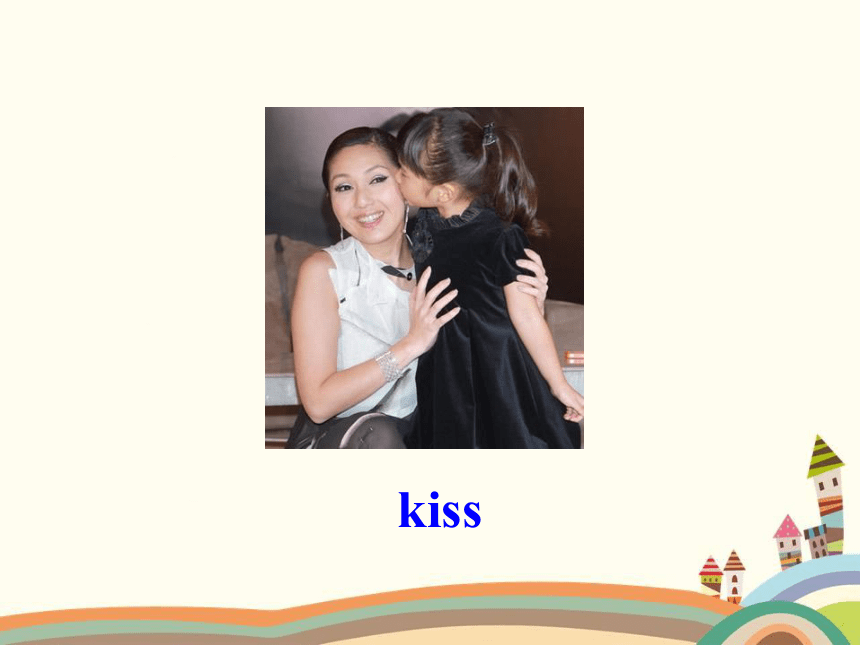
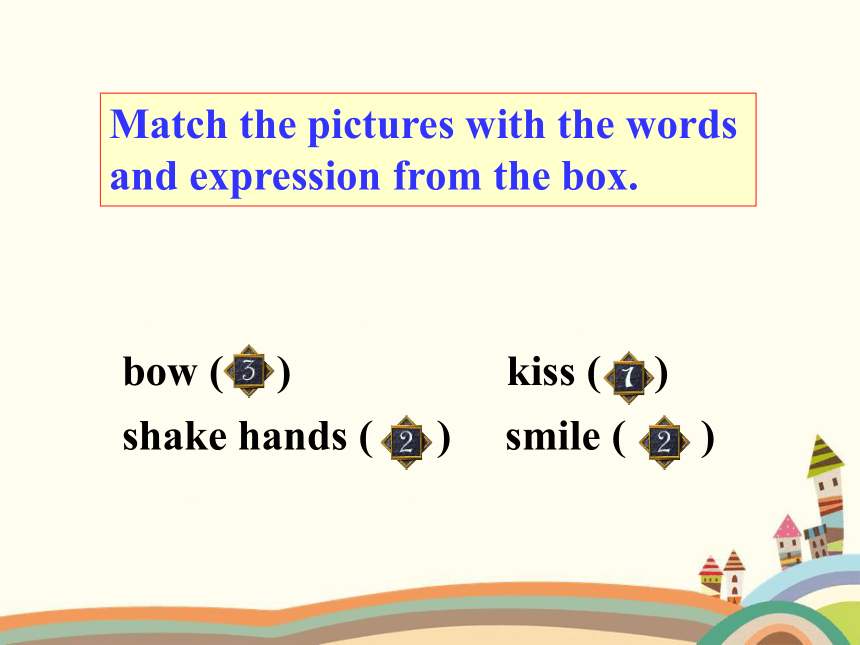
文档简介
(共38张PPT)
1. To learn the key words and useful
expressions in the dialogue
2. To know the body languages in Russia, in China, in the US and in New Zealand
Teaching aims
bow
kiss
shake
shake hands
smile
British
German
Japanese
v. 鞠躬,弯腰
v. & n. 吻,亲吻
v. 摇晃
握手
v. & n. 微笑
adj. 英国的,英国人的
n. 德国人;德语
adj. 德国(人)的;德语的
n. 日本人;日语
adj. 日本(人)的;日语的
visitor
Russia
what
nod
head
hug
each
each other
n. 游客,观光者
n. 俄罗斯
int. 什么(表示惊奇)
v. 点(头)
n. 头,头部
v. 拥抱,紧抱
pron. 各个,每个
互相;彼此
India
together
Maori
touch
nose
n. 印度
adv. 一起;共同
adj. 毛利人的
v. 触摸;接触
n. 鼻子
根据首字母及句子意思,填入恰当的词。
1. “Welcome!”, she s_____ hands and smiles.
2. She came and gave her grandpa’s a h__.
3. If you agree my ideas, you n__ your head.
4. Maori people in New Zealand t____ noses when they meet.
5. They b__ to their king every morning.
hakes
ug
od
ouch
ow
leading-in 请说出下面的肢体语言
smile
shake hands
bow
kiss
Match the pictures with the words and expression from the box.
bow ( ) kiss ( )
shake hands ( ) smile ( )
People from different countries have different ways of body languages to greet each other. Look at the following pictures.
Chinese way
Shake hands and smile
Russian way
Kiss three times
American way
Shake hands, kiss or hug
Indian way
Put hands together and nod heads
Maori people
Touch noses
British French German Japanese Russian
Listen and match the pictures with the nationality.
3
2
1
— Are they Russian
— Yes, they are.
— What are they doing
— They’re shaking hands.
1. Who will come to Lingling’s school
Some Russian teachers.
2. What will Maori people do when they
meet
They will touch noses.
India kiss Russia together touch visitor
kiss
In China, people shake hands and smile
American people shake hands and sometimes (1) ______
Watch and complete the table with the correct form of the words from the box.
In (2) ______, people put their hands (3) ________ and nod their heads when they meet
(6) ________.
In (4) _______, people kiss each other three times
Maori people (5) ______ noses.
India
together
Russia
touch
visitors
What!
I didn’t know that.
Chinese each French
teacher touch
British shake
people
French
British
Listen and repeat.
your teacher
your head teacher
your parents after school
Talk about what you do and say when you meet:
your best friend
your best friend’s parents
your favourite film star
a visitor to your school
an American
a Russian
— What do you do and say when you
meet your teacher in the morning
— I smile and say good morning.
— What do you do and say when you
meet a Russian
— I smile, say hello and kiss each
other three times.
— What do you do and say when you
meet your parents after school
— Kiss and hug each other.
We Chinese often shake hands and
smile.
shake hands 表示“握手”。
Shake hands with sb.
表示“和某人握手”。
2. 名词的复数:
German → Germans
Japanese → Japanese
Russian → Russians
3. And some kiss or hug each other.
each other 表示“彼此,互相”, 通常放在动词后。
4. In India people put their hands together
and nod their heads.
put … together 表示“把……放在一起”。
5. They touch noses!
touch noses 表示“碰鼻子”。
6. That’s because people do different
things in different countries.
That’s because … 表示“那是因为……”。
Some ______ visit the Great Wall
every year.
A. visiter B. visitor C. visitors
2. Chinese often _____ when they meet.
A. shake hands B. shakes hands
C. touch noses
单项选择
3. They help ______ when they are in
trouble.
A. each B. each other C. the other
4. They all live _____ in a three-bedroom
house.
A. together B. with C. each
5. Would you like to talk with _______
A. German B. Germans
C. Germen
根据今天所学内容,完成短文。
In _____, people shake hands and smile when they meet visitors. In ______________, people shake hand and sometimes kiss. In _____, people put their hand together and nod their heads. In ______, people usually kiss three times, In ___________, Maori people touch noses.
China
America/the US
India
Russia
New Zealand
Make a dialogue in pairs when you meet a foreigner.
1. To learn the key words and useful
expressions in the dialogue
2. To know the body languages in Russia, in China, in the US and in New Zealand
Teaching aims
bow
kiss
shake
shake hands
smile
British
German
Japanese
v. 鞠躬,弯腰
v. & n. 吻,亲吻
v. 摇晃
握手
v. & n. 微笑
adj. 英国的,英国人的
n. 德国人;德语
adj. 德国(人)的;德语的
n. 日本人;日语
adj. 日本(人)的;日语的
visitor
Russia
what
nod
head
hug
each
each other
n. 游客,观光者
n. 俄罗斯
int. 什么(表示惊奇)
v. 点(头)
n. 头,头部
v. 拥抱,紧抱
pron. 各个,每个
互相;彼此
India
together
Maori
touch
nose
n. 印度
adv. 一起;共同
adj. 毛利人的
v. 触摸;接触
n. 鼻子
根据首字母及句子意思,填入恰当的词。
1. “Welcome!”, she s_____ hands and smiles.
2. She came and gave her grandpa’s a h__.
3. If you agree my ideas, you n__ your head.
4. Maori people in New Zealand t____ noses when they meet.
5. They b__ to their king every morning.
hakes
ug
od
ouch
ow
leading-in 请说出下面的肢体语言
smile
shake hands
bow
kiss
Match the pictures with the words and expression from the box.
bow ( ) kiss ( )
shake hands ( ) smile ( )
People from different countries have different ways of body languages to greet each other. Look at the following pictures.
Chinese way
Shake hands and smile
Russian way
Kiss three times
American way
Shake hands, kiss or hug
Indian way
Put hands together and nod heads
Maori people
Touch noses
British French German Japanese Russian
Listen and match the pictures with the nationality.
3
2
1
— Are they Russian
— Yes, they are.
— What are they doing
— They’re shaking hands.
1. Who will come to Lingling’s school
Some Russian teachers.
2. What will Maori people do when they
meet
They will touch noses.
India kiss Russia together touch visitor
kiss
In China, people shake hands and smile
American people shake hands and sometimes (1) ______
Watch and complete the table with the correct form of the words from the box.
In (2) ______, people put their hands (3) ________ and nod their heads when they meet
(6) ________.
In (4) _______, people kiss each other three times
Maori people (5) ______ noses.
India
together
Russia
touch
visitors
What!
I didn’t know that.
Chinese each French
teacher touch
British shake
people
French
British
Listen and repeat.
your teacher
your head teacher
your parents after school
Talk about what you do and say when you meet:
your best friend
your best friend’s parents
your favourite film star
a visitor to your school
an American
a Russian
— What do you do and say when you
meet your teacher in the morning
— I smile and say good morning.
— What do you do and say when you
meet a Russian
— I smile, say hello and kiss each
other three times.
— What do you do and say when you
meet your parents after school
— Kiss and hug each other.
We Chinese often shake hands and
smile.
shake hands 表示“握手”。
Shake hands with sb.
表示“和某人握手”。
2. 名词的复数:
German → Germans
Japanese → Japanese
Russian → Russians
3. And some kiss or hug each other.
each other 表示“彼此,互相”, 通常放在动词后。
4. In India people put their hands together
and nod their heads.
put … together 表示“把……放在一起”。
5. They touch noses!
touch noses 表示“碰鼻子”。
6. That’s because people do different
things in different countries.
That’s because … 表示“那是因为……”。
Some ______ visit the Great Wall
every year.
A. visiter B. visitor C. visitors
2. Chinese often _____ when they meet.
A. shake hands B. shakes hands
C. touch noses
单项选择
3. They help ______ when they are in
trouble.
A. each B. each other C. the other
4. They all live _____ in a three-bedroom
house.
A. together B. with C. each
5. Would you like to talk with _______
A. German B. Germans
C. Germen
根据今天所学内容,完成短文。
In _____, people shake hands and smile when they meet visitors. In ______________, people shake hand and sometimes kiss. In _____, people put their hand together and nod their heads. In ______, people usually kiss three times, In ___________, Maori people touch noses.
China
America/the US
India
Russia
New Zealand
Make a dialogue in pairs when you meet a foreigner.
同课章节目录
- Module 1 Lost and found
- Unit 1 Whose bag is this?
- Unit 2 Are they yours?
- Unit 3 Language in use
- Module 2 What can you do ?
- Unit 1 I can play the piano
- Unit 2 I can run really fast
- Unit 3 Language in use
- Module 3 Making plans
- Unit 1 What are you going to do at the weekends?
- Unit 2 We're going to cheer the players.
- Unit 3 Language in use
- Module 4 Life in the future
- Unit 1 Everyone will study at home
- Unit 2 Every family will have a small plane.
- Unit 3 Language in use
- Module 5 Shopping
- Unit 1 What can I do for you?
- Unit 2 You can buy everything on the Internet
- Unit 3 Language in use
- Module 6 Around town
- Unit 1 Could you tell me how to get to the Nationa
- Unit 2 The London Eye is on your right.
- Unit 3 Language in use
- Revision module A
- Module 7 My past life
- Unit 1 I was born in a small village.
- Unit 2 I was born in Quincy.
- Unit 3 Language in use
- Module 8 Story time
- Unit 1 Once upon a time….
- Unit 2 Goldilocks hurried out of the house.
- Unit 3 Language in use
- Module 9 Life history
- Unit 1 He left school and began work at the age of
- Unit 2 He decided to be an actor.
- Unit 3 Language in use
- Module 10 A holiday journey
- Unit 1 What did you do?
- Unit 2 This morning we took a walk.
- Unit 3 Language in use
- Module 11 Body language
- Unit 1 They touch noses!
- Unit 2 Here are some ways to welcome them.
- Unit 3 Language in use
- Module 12 Western music
- Unit 1 It's so beautiful!
- Unit 2 Vienna is the centre of European classical
- Unit 3 Language in use
- Revision module B
